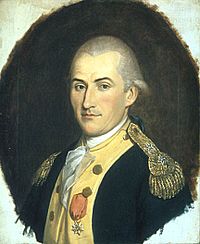Louis Lebègue Duportail facts for kids
Quick facts for kids
Louis Lebègue de Presle Duportail
|
|
|---|---|
 |
|
| 1st Minister of War | |
| In office 25 May 1791 – 7 December 1791 |
|
| Monarch | Louis XVI |
| Preceded by | Office established |
| Succeeded by | Louis de Narbonne-Lara |
| 41st Secretary of State for War | |
| In office 16 November 1790 – 25 May 1791 |
|
| Monarch | Louis XVI |
| Preceded by | Jean-Frédéric de la Tour du Pin-Gouvernet |
| Succeeded by | Office abolished |
| 2nd Chief of Engineers | |
| In office 22 July 1777 – 10 October 1783 |
|
| Preceded by | Rufus Putnam |
| Succeeded by | Stephen Rochefontaine |
| Personal details | |
| Born | 14 May 1743 Pithiviers, Kingdom of France |
| Died | 12 August 1802 (aged 59) |
| Military service | |
| Allegiance | |
| Branch/service | French Army, US Army |
| Years of service | 1765–1790 |
| Rank | Major general |
| Battles/wars | American Revolutionary War |
Louis Antoine Jean Le Bègue de Presle Duportail (born May 14, 1743 – died August 12, 1802) was an important French military leader. He helped the Continental Army during the American Revolutionary War as their main engineer. Later, he became the last Secretary of State for War and the first Minister of War in France, right at the start of the French Revolution.
Contents
Early Life and Military Training
Louis Duportail was born in 1743 near Orléans, a city in France. He went to a special school for engineers in Charleville-Mézières. In 1765, he finished his studies and became a skilled engineer officer. This training would be very useful in his future career.
Helping America in the Revolution
Joining the Continental Army
In March 1777, Duportail was a lieutenant colonel in the French Royal Corps of Engineers. He was sent secretly to America to help the Continental Army. This was part of an agreement between Benjamin Franklin and King Louis XVI of France. France wanted to help the American colonists win their independence from Britain.
Duportail's Role as Chief Engineer
Duportail quickly rose through the ranks in the Continental Army. In July 1777, he was made a colonel and put in charge of all engineers. By November 1777, he became a brigadier general. He was named commander of the United States Army Corps of Engineers in May 1779. Finally, in November 1781, he was promoted to major general.
His main job was to plan and build fortifications. These were defensive structures like forts and trenches. He worked on defenses from Boston, Massachusetts all the way down to Charleston, South Carolina.
Key Contributions to the War
Duportail helped George Washington develop a smart military plan. This plan focused on defending positions and wearing down the British army. He was captured when Charleston surrendered in May 1780, but he was later exchanged.
During the tough winter at Valley Forge National Historical Park in 1777-1778, Duportail's headquarters was at Cressbrook Farm. He played a crucial role in planning the siege works at the Battle of Yorktown. This battle was a major victory for the American and French forces, and it helped end the Revolutionary War.
Return to France and Political Career
Serving as Minister of War
After the American Revolutionary War ended, Duportail went back to France in October 1783. He became an infantry officer and was promoted to Marechal-de-Camp (which is like a brigadier general) in 1788.
From November 1790 to December 1791, he served as France's Minister of War. This was a very important time, as the French Revolution was just beginning. He worked to make reforms and improvements in the French military.
Escape and Final Years
As the French Revolution became more extreme, Duportail faced danger from radical groups like the Jacobins. He was forced to go into hiding. Eventually, he managed to escape back to America. He bought a farm near Valley Forge, Pennsylvania, where he had served during the war.
Duportail lived there until 1802. He died at sea while trying to return to France one last time.

